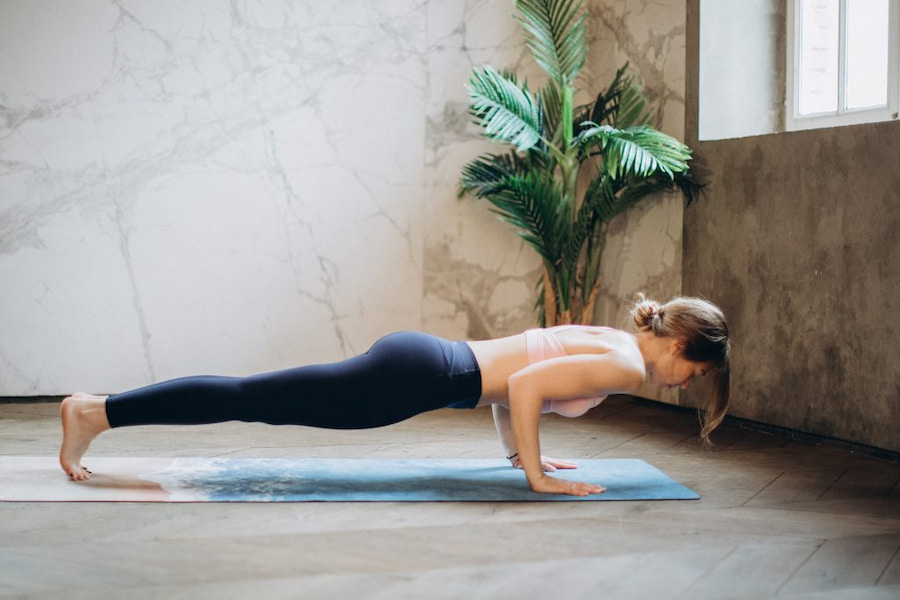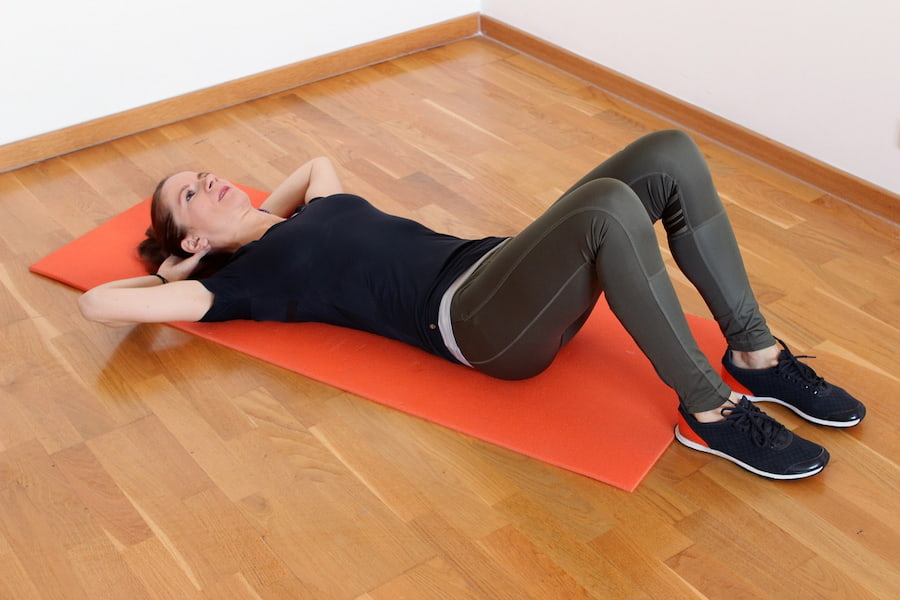Traditional ab training often involved simple exercises and high repetition sets, although it often prioritised muscle fatigue over proper form and movement quality. This stemmed from the misguided belief in spot reduction, the idea that you could target and burn fat in specific areas through repetitive exercise.
It’s a good thing that modern science debunks this myth. Spot reduction isn’t effective. However, that doesn’t mean we can’t learn from our fitness history. These bodyweight ab exercises, requiring no equipment and ideal for home workouts, offer an excellent way to train your core for strength and stability, a far more effective approach than focusing solely on fatigue.
5 Home Ab Exercises With No Equipment

1. Crunch
The crunch isn’t just a fitness fad; it’s a classic core exercise for a reason. In a 2016 publication, namely the Strength and Conditioning Journal, Drs Morey Kolber and Brad Schoenfeld reiterated that abdominal crunch exercises improve fitness attributes, sports performance, and core muscle function. The crunch effectively engages your entire abdominal area, leading to a satisfying contraction with each rep.
Here’s how to nail the perfect crunch:
- Lie flat on your back with your knees bent and feet flat on the floor. Keep your arms crossed across your chest or lightly rest them behind your head.
- Initiate the movement by contracting your abdominal muscles, bringing your upper torso off the ground. Focus on drawing your ribs towards your hips, not pulling with your arms or hunching your shoulders.
- Hold the peak contraction for a second, feeling the burn in your abs, before slowly lowering back down with control. Maintain a slight curve in your lower back throughout the movement.
- Aim for 3 sets of 10-20 repetitions to start, gradually increasing the reps as you build strength.

2. Plank
While crunches isolate specific ab muscles, the plank engages your entire core like nothing else. It mimics how we use these muscles daily for stabilisation, making it a functional and challenging exercise.
Here’s how to do the Plank:
- Start in a high plank position, shoulders over elbows, wrists below shoulders. Engage your core and glutes to form a rigid line from head to heels.
- Breathe deeply and brace your core tightly. Imagine drawing your belly button towards your spine. Don’t let your hips sag or arch your back.
- Start with 3 sets of 30 seconds, aiming for perfect form throughout. Rest for the same duration between sets.
Feeling confident? Elevate the plank by placing your elbows slightly forward for a more intense core burn. Alternatively, load a backpack for some resistance and extra stabilisation challenge.

3. Leg Raises
Target those elusive lower abdominals with the simple yet effective leg raise. This exercise engages your core throughout the movement, promoting both strength and definition.
Follow these steps:
- Lie flat on your back with your legs extended and your toes pointed. For additional support, place your hands under your glutes.
- Slowly raise your legs from the ground, aiming for about a foot high. Engage your core to maintain a straight back and avoid swinging your hips.
- Slowly lower your legs back down without touching the ground. Repeat for the desired number of repetitions.
Start with 15 controlled repetitions for 2-4 sets. You’ll feel the burn, but the sculpted lower abs will be your well-earned reward.

4. Heel Taps
Heel taps offer a dynamic way to engage your obliques and upper abs, building rotational strength and definition.
- Here’s the procedure:
- Lie flat on your back with your knees bent and feet flat on the floor. Keep your legs and knees pressed together, high towards your chest.
- Reach your hands out to your sides at shoulder height. Contract your left oblique and tap your left heel with your left hand, keeping your right shoulder off the ground for a controlled, twisting motion.
- Quickly, but with control, contract your right oblique and tap your right heel with your right hand. This one complete side-to-side movement counts as one repetition.
- Continue alternating heel taps, maintaining a slight lift on your upper body to engage your abs throughout. Aim for 3 sets of 30 repetitions per heel (60 total) to start, gradually increasing as you gain strength.
Lightly engaging your core alongside your obliques creates a smooth motion and protects your back. This slight lift also prevents friction on your mat, making the exercise more comfortable.

5. Mountain Climbers
Mountain climbers combine core contraction and stabilisation, making them a fantastic exercise for building strength and boosting your cardio. They’re a perfect finisher for any ab workout, leaving you feeling powerful and pumped.
- Here’s how to do the Mountain Climber:
- Assume a high plank position, shoulders over wrists, core engaged, forming a straight line from head to heels.
- Drive your right knee towards your chest, touching the ground with the ball of your foot or hovering just above. Maintain a strong, flat back throughout the movement.
- Simultaneously as you return your right leg to the starting position, drive your left knee towards your chest in a rapid, controlled motion. Keep your core engaged and hips stable.
- Aim for 20 repetitions per leg (40 total) for 4 sets initially. Increase the speed and reps as your fitness improves.
Focus on quality over quantity. Maintain proper form with each knee drive, avoiding arching your back or letting your hips dip.
Final Thoughts
Building a strong core isn’t just about vanity – it’s about giving your entire body a foundation for success. These at-home exercises coupled with the right workout nutrition and knowledge on what food to avoid empower you to sculpt those abs and unlock hidden strength in all your movements.